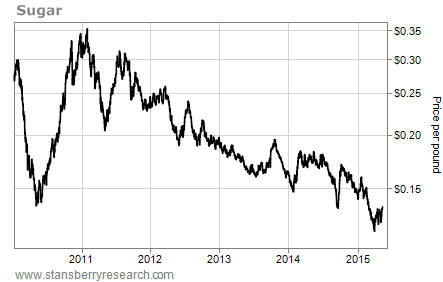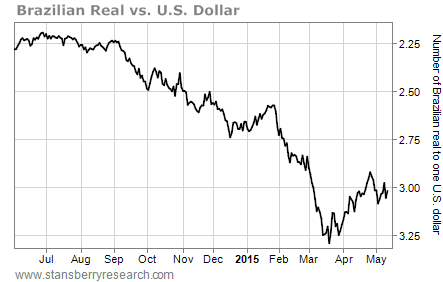One of the world’s largest commodity firms just made a big bet on sugar.
If you’re interested in making money in the commodities sector, you should consider doing the same…
Wilmar International is Asia’s leading agribusiness firm. The $20 billion company’s business activities include processing palm oils and refining edible oils and specialty fats. It’s also the world’s largest raw-sugar producer and refiner.
[ad#Google Adsense 336×280-IA]Earlier this month, Wilmar made headlines when it bought a record 1.9 million metric tons of raw sugar against a May futures contract.
To put this number into perspective, it’s more than 1% of the world’s total annual sugar production.
This is a big deal.
As regular Growth Stock Wire readers know, futures contracts are an agreement to buy a certain asset at a certain price on a certain day.
However, about 90% of futures contracts go undelivered.
Even if the owner of the position has a gain (meaning the price of the commodity is now higher than what he paid), he normally sells the contract. Few owners choose to receive the underlying commodity.
So Wilmar choosing to receive the sugar was a surprise. And the amount of sugar set a new record, according to Intercontinental Exchange (ICE) data that date back to 1989. Wilmar also asked for the delivery to be made as soon as possible. Several firms will deliver the sugar from ports in Brazil, Honduras, and Guatemala.
So why is Wilmar suddenly buying raw sugar? In short, it’s betting prices are about to rally.
My colleague Matt Badiali told you about the opportunity setting up in sugar in January. From 2010 to early 2011, sugar saw a huge boom. Prices more than doubled in less than a year.
Rising prices caused farmers to increase their sugar production. But this led to an oversupply… and sugar prices crashed. Although prices have recently increased 14% from their March low, they’re still down around 60% from their 2011 highs.
 But that’s about to change…
But that’s about to change…
Sugar production is set to fall this year in the world’s main sugar-producing countries thanks to below-average rainfall forecasts and the potential of an El Niño event.
An El Niño event occurs when the Pacific Ocean becomes unusually warm. And it affects weather worldwide.
In Australia (the world’s ninth-largest sugar producer) and India (the world’s second-largest sugar producer), an El Niño causes severe drought – which limits sugar-cane growth. For example, the El Niño in 2009 caused the worst drought in four decades in India.
In Brazil (the world’s largest sugar producer), an El Niño has the opposite effect. It causes torrential rains, which adversely affect production, too. High water levels increase disease and pests. It also makes harvesting sugar cane more difficult. For example, according to commodity broker Marex Spectron, the El Niño in 1997 caused sugar production in Brazil to decline by 2%. That was the only year in the last decade when production fell.
Australia, Japan, and the U.S. have all said that an El Niño event emerged in February. And the U.S. Climate Prediction Center says there’s a “70% chance the pattern will continue through the Northern Hemisphere this summer.” Australia’s weather bureau has even said this year’s event will probably be “substantial.”
So we could soon see sugar production decrease significantly.
Meanwhile, as Matt showed you in January, sugar demand is increasing in places like China and India.
Jack Scoville, senior market analyst for the PRICE Futures Group in Chicago, also says analysts expect refiners (especially in Brazil) will convert more sugar cane to ethanol if the price of crude oil remains at current levels.
You see, the recent increase in the price of crude oil from its mid-March lows (it’s up around 44%) makes petroleum products (like ethanol) more valuable. As more sugar goes to fuel production, it will help increase sugar demand and the price.
Thanks to increasing consumption and decreasing production, the U.S. Department of Agriculture (USDA) expects sugar inventories to fall this year for the first time since the 2010-2011 crop year.
These are some of the reasons Wilmar is buying sugar right now. But they’re not the only reasons to be bullish on sugar today…
Scoville says the Brazilian real is another reason we could soon see higher sugar prices.
From the end of June to mid-March, the U.S. dollar was on a tear. It appreciated 50% against the Brazilian real. The move helped sugar prices stay low.
Like most commodities, sugar is priced in U.S. dollars. But the production costs to make sugar in Brazil (which, as I said, is the world’s largest sugar producer) are in reals. That means the cheaper the real is to the dollar, the cheaper Brazil can sell its sugar to the rest of the world.
But it looks like the real has bottomed against the dollar. It has appreciated 7.5% versus the dollar since its mid-March low. You can see this in the chart below (the higher the line, the more valuable the real is versus the dollar).
 With the real rising, so will the price of Brazil’s sugar.
With the real rising, so will the price of Brazil’s sugar.
So, there are several reasons why sugar prices are likely to rally this year. Of course, we can’t know for sure what the weather will do, so this is a speculative trade. But one of the world’s largest sugar producers is making the bet. If you want to profit in the commodities sector, you should consider doing the same.
Traders looking to speculate on increasing sugar prices can buy one of three exchange-traded funds with exposure to sugar: the iPath Dow Jones-UBS Sugar Subindex Total Return Fund (SGG), the iPath Pure Beta Sugar Fund (SGAR), and the Teucrium Sugar Fund (CANE). These funds are already beginning to head higher with the price of sugar. And they should continue to do well as sugar prices recover.
Good investing,
Brian Weepie
[ad#stansberry-ps]
Source: Growth Stock Wire
